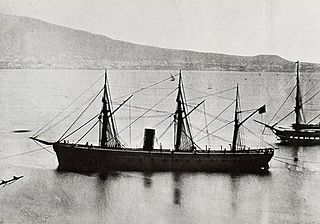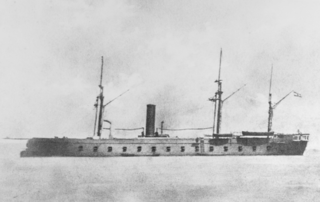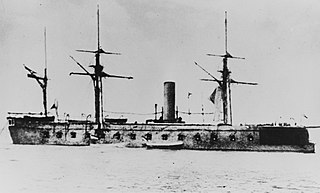
The Battle of Lissa was a naval battle between an Italian and an Austrian fleet during the Third Italian War of Independence. It took place on July 20, 1866, near the island of Vis, which is now part of Croatia. The Kingdom of Italy intended to capture Habsburg Venetia and break Austria's naval dominance in the Adriatic. However, the Imperial Austrian Navy managed to secure victory despite the numerical and technical superiority of the Italian fleet by employing ramming tactics. This battle was the first naval engagement in which newly developed ironclad warships were used on a significant scale. Both naval forces at Lissa exhibited notable technical deficiencies, while the Italian Navy also suffered from severe rivalries within its command staff and inadequate training of its crews.

Re d'Italia was the lead ship of the Re d'Italia-class armored frigates built in the United States for the Italian Regia Marina in the early 1860s. She was laid down at the William H. Webb Shipyard in New York in November 1861, was launched in April 1863, and was completed a year later in September 1864; the two Re d'Italia-class ships were the only Italian ironclads built in the United States. The ships were broadside ironclads, armed with a battery of six 72-pounder guns and thirty-two 164 mm (6.5 in) guns.

SMS Kaiser was a 92-gun wooden ship of the line of the Austrian Navy, the last vessel of the type, and the only screw-driven example, to be built by the Austrians. She was built by the naval shipyard in Pola; she was laid down in March 1855, was launched in October 1858, and was completed the following year. The ship took part in the Second Schleswig War of 1864, but saw no action during her deployment to the North Sea. Kaiser did see action during the Seven Weeks' War two years later, during which she took part in the Battle of Lissa as the flagship of Anton von Petz, commander of the Austrian 2nd Division. Kaiser engaged several Italian ironclads simultaneously, rammed one—Re di Portogallo—and damaged another—Affondatore—with gunfire. In doing so, she became the only wooden ship of the line to engage an ironclad warship in battle.

SMS Salamander was a Drache-class armored frigate built for the Austro-Hungarian Navy in the 1860s; she was laid down in February 1861, launched in August that year, and completed in May 1862, six months before her sister Drache. She was a broadside ironclad, mounting a battery of twenty-eight guns in gun ports along the length the hull. During the Second Schleswig War in 1864, Salamander remained in the Adriatic to protect Austria from a possible Danish attack that did not materialize. Two years later, during the Seven Weeks' War, she participated in the Austrian victory over a superior Italian fleet in the Battle of Lissa in July 1866. Immediately after the war, she was modernized with a battery of more powerful guns. Little used thereafter owing to reduced naval budgets, she was stricken from the Navy List in 1883 and hulked for use as a mine storage ship before being broken up in 1895–1896.

Re di Portogallo was an ironclad warship built for the Italian Regia Marina in the 1860s, the second and final member of the Re d'Italia class. She was laid down at the William H. Webb Shipyard in New York in December 1861, was launched in August 1863, and was completed a year later in August 1864; the two Re d'Italia-class ships were the only Italian ironclads built in the United States. The ships were broadside ironclads, armed with a battery of six 72-pounder guns and thirty-two 164 mm (6.5 in) guns.

The Re d'Italia class was a pair of ironclad warships built for the Italian Regia Marina in the 1860s. The class comprised two ships, Re d'Italia and Re di Portogallo. The two ships were built in the United States, and were based on the French ironclad Gloire; they were armed with a battery of thirty-eight guns in a broadside arrangement and were protected with 120 mm (4.7 in) of wrought iron plating.

SMS Erzherzog Albrecht was an ironclad warship built for the Austro-Hungarian Navy in the 1870s, the only member of her class. Her design was similar to the ironclad Custoza, but Erzherzog Albrecht was built to a smaller size; like Custoza, she was an iron-hulled casemate ship armed with a battery of eight heavy guns. The ship was laid down in June 1870, was launched in April 1872, and was commissioned in June 1874. The ship's service career was limited; tight naval budgets precluded an active fleet policy in the 1870s, which did not markedly improve in the 1880s. Her first period of active service came in 1881 and 1882, when she helped suppress a revolt in Cattaro Bay. In 1908, she was converted into a tender for the gunnery training school, having been renamed Feuerspeier. In 1915, she became a barracks ship, and after World War I ended in 1918, was ceded to Italy as a war prize. She was renamed Buttafuoco, served in the Italian Navy as a hulk through World War II before being scrapped in 1950.

The Erzherzog Ferdinand Max class consisted of a pair of ironclad warships—Erzherzog Ferdinand Max and Habsburg—built for the Austrian Navy in the 1860s. They were the last broadside armored frigates to be built for the Austrian Empire, and the last vessels completed to see action against the Italians at the Battle of Lissa in 1866. Intended to have been armed with new breech-loading Krupp guns, the outbreak of the Seven Weeks' War prevented the delivery of the guns, forcing the Austrian Navy to arm the ships with a battery of sixteen older 48-pounder muzzle-loading guns.

SMS Erzherzog Ferdinand Max was the lead ship of the Erzherzog Ferdinand Max class of broadside ironclads built for the Austrian Navy in the 1860s. She was built by the Stabilimento Tecnico Triestino, with her keel laying in October 1863, launching in May 1865, and commissioning in June 1866 at the outbreak of the Third Italian War of Independence and the Austro-Prussian War, fought concurrently. The ship was armed with a main battery of sixteen 48-pounder guns, though the rifled guns originally intended, which had been ordered from Prussia, had to be replaced with old smoothbore guns until after the conflicts ended.

SMS Habsburg was the second and final member of the Erzherzog Ferdinand Max class of broadside ironclads built for the Austrian Navy in the 1860s. She was built by the Stabilimento Tecnico Triestino; her keel was laid down in June 1863, she was launched in June 1865, and commissioning in June 1866 at the outbreak of the Third Italian War of Independence and the Austro-Prussian War, fought concurrently. The ship was armed with a main battery of sixteen 48-pounder guns, though the rifled guns originally intended, which had been ordered from Prussia, had to be replaced with old smoothbore guns until after the conflicts ended.

SMS Kaiser Max was the lead ship of the Kaiser Max class of armored frigates built for the Austrian Navy in the 1860s. Her keel was laid in October 1861 at the Stabilimento Tecnico Triestino shipyard; she was launched in May 1862, and was completed in 1863. She carried her main battery—composed of sixteen 48-pounder guns and fifteen 24-pounders—in a traditional broadside arrangement, protected by an armored belt that was 110 mm (4.3 in) thick.

SMS Prinz Eugen was the second member of the Kaiser Max class built for the Austrian Navy in the 1860s. Her keel was laid in October 1861 at the Stabilimento Tecnico Triestino shipyard; she was launched in June 1862, and was completed in March 1863. She carried her main battery—composed of sixteen 48-pounder guns and fifteen 24-pounders—in a traditional broadside arrangement, protected by an armored belt that was 110 mm (4.3 in) thick.

SMS Don Juan d'Austria was the third member of the Kaiser Max class built for the Austrian Navy in the 1860s. Her keel was laid in October 1861 at the Stabilimento Tecnico Triestino shipyard; she was launched in July 1862, and was completed in 1863. She carried her main battery—composed of sixteen 48-pounder guns and fifteen 24-pounders—in a traditional broadside arrangement, protected by an armored belt that was 110 mm (4.3 in) thick.

A naval arms race between the Austrian Empire and Italy began in the 1860s when both ordered a series of ironclad warships, steam-propelled vessels protected by iron or steel armor plates and far more powerful than all-wood ships of the line. These ships were constructed to establish control over the Adriatic Sea in the event of a conflict between the two countries.

SMS Radetzky was a screw frigate in the Austro-Hungarian Navy, built in England in 1856. She was lost after the detonation of her powder magazine in 1869.

SMS Erzherzog Friedrich was a screw corvette of the Austrian Navy, and was built in the 1850s. She was the lead ship of the Erzherzog Friedrich class, the first vessels of that type built for the Austrian fleet. She had one sister ship, Dandolo.

SMS Dandolo was the second and final member of the Erzherzog Friedrich class of screw corvettes built for the Austrian Navy in the 1850s.
SMS Adria was the second of three Radetzky class of screw frigates built for the Austrian Navy in the 1850s.

SMS Schwarzenberg was a frigate of the Austrian Navy, built in the 1850s, the only member of her ship class. She was converted into a screw frigate in the early 1860s. Schwarzenberg saw significant action during her career, leading the Austro-Prussian squadron at the Battle of Heligoland in the 1864 Second Schleswig War and participating in the Battle of Lissa during the Third Italian War of Independence.















